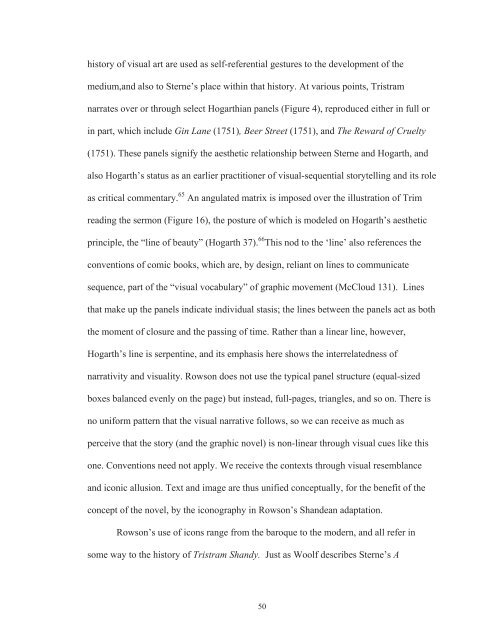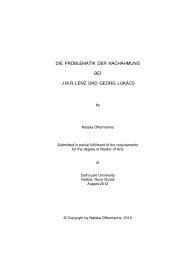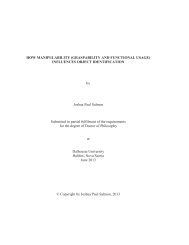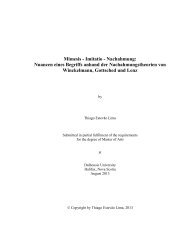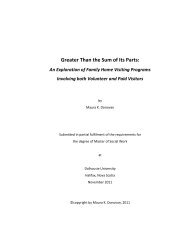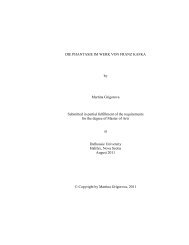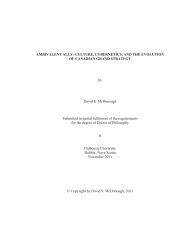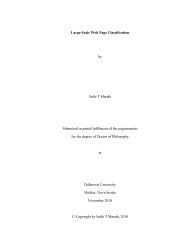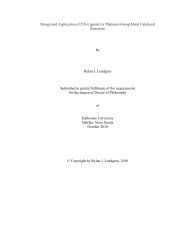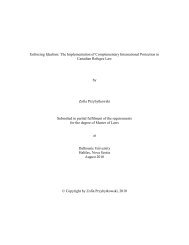ADAPTING TRISTRAM SHANDY by Adria Young Submitted in ...
ADAPTING TRISTRAM SHANDY by Adria Young Submitted in ...
ADAPTING TRISTRAM SHANDY by Adria Young Submitted in ...
You also want an ePaper? Increase the reach of your titles
YUMPU automatically turns print PDFs into web optimized ePapers that Google loves.
history of visual art are used as self-referential gestures to the development of the<br />
medium,and also to Sterne’s place with<strong>in</strong> that history. At various po<strong>in</strong>ts, Tristram<br />
narrates over or through select Hogarthian panels (Figure 4), reproduced either <strong>in</strong> full or<br />
<strong>in</strong> part, which <strong>in</strong>clude G<strong>in</strong> Lane (1751), Beer Street (1751), and The Reward of Cruelty<br />
(1751). These panels signify the aesthetic relationship between Sterne and Hogarth, and<br />
also Hogarth’s status as an earlier practitioner of visual-sequential storytell<strong>in</strong>g and its role<br />
as critical commentary. 65 An angulated matrix is imposed over the illustration of Trim<br />
read<strong>in</strong>g the sermon (Figure 16), the posture of which is modeled on Hogarth’s aesthetic<br />
pr<strong>in</strong>ciple, the “l<strong>in</strong>e of beauty” (Hogarth 37). 66 This nod to the ‘l<strong>in</strong>e’ also references the<br />
conventions of comic books, which are, <strong>by</strong> design, reliant on l<strong>in</strong>es to communicate<br />
sequence, part of the “visual vocabulary” of graphic movement (McCloud 131). L<strong>in</strong>es<br />
that make up the panels <strong>in</strong>dicate <strong>in</strong>dividual stasis; the l<strong>in</strong>es between the panels act as both<br />
the moment of closure and the pass<strong>in</strong>g of time. Rather than a l<strong>in</strong>ear l<strong>in</strong>e, however,<br />
Hogarth’s l<strong>in</strong>e is serpent<strong>in</strong>e, and its emphasis here shows the <strong>in</strong>terrelatedness of<br />
narrativity and visuality. Rowson does not use the typical panel structure (equal-sized<br />
boxes balanced evenly on the page) but <strong>in</strong>stead, full-pages, triangles, and so on. There is<br />
no uniform pattern that the visual narrative follows, so we can receive as much as<br />
perceive that the story (and the graphic novel) is non-l<strong>in</strong>ear through visual cues like this<br />
one. Conventions need not apply. We receive the contexts through visual resemblance<br />
and iconic allusion. Text and image are thus unified conceptually, for the benefit of the<br />
concept of the novel, <strong>by</strong> the iconography <strong>in</strong> Rowson’s Shandean adaptation.<br />
Rowson’s use of icons range from the baroque to the modern, and all refer <strong>in</strong><br />
some way to the history of Tristram Shandy. Just as Woolf describes Sterne’s A<br />
50


